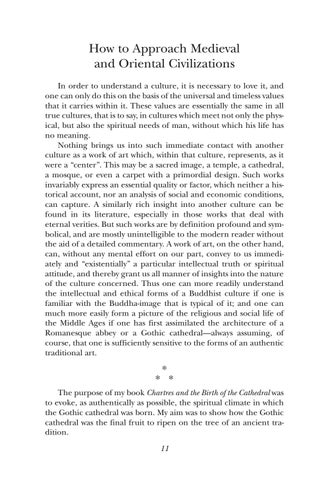How to Approach Medieval and Oriental Civilizations In order to understand a culture, it is necessary to love it, and one can only do this on the basis of the universal and timeless values that it carries within it. These values are essentially the same in all true cultures, that is to say, in cultures which meet not only the physical, but also the spiritual needs of man, without which his life has no meaning. Nothing brings us into such immediate contact with another culture as a work of art which, within that culture, represents, as it were a “center”. This may be a sacred image, a temple, a cathedral, a mosque, or even a carpet with a primordial design. Such works invariably express an essential quality or factor, which neither a historical account, nor an analysis of social and economic conditions, can capture. A similarly rich insight into another culture can be found in its literature, especially in those works that deal with eternal verities. But such works are by definition profound and symbolical, and are mostly unintelligible to the modern reader without the aid of a detailed commentary. A work of art, on the other hand, can, without any mental effort on our part, convey to us immediately and “existentially” a particular intellectual truth or spiritual attitude, and thereby grant us all manner of insights into the nature of the culture concerned. Thus one can more readily understand the intellectual and ethical forms of a Buddhist culture if one is familiar with the Buddha-image that is typical of it; and one can much more easily form a picture of the religious and social life of the Middle Ages if one has first assimilated the architecture of a Romanesque abbey or a Gothic cathedral—always assuming, of course, that one is sufficiently sensitive to the forms of an authentic traditional art.
*
* * The purpose of my book Chartres and the Birth of the Cathedral was to evoke, as authentically as possible, the spiritual climate in which the Gothic cathedral was born. My aim was to show how the Gothic cathedral was the final fruit to ripen on the tree of an ancient tradition. 11
